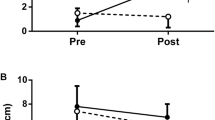Abstract
Purpose
To describe the neuromuscular and perceptual responses to incline, decline or level treadmill exercise.
Methods
Fifteen healthy subjects performed on separate days 45 min treadmill exercise at 75% heart rate reserve in a level (+ 1% slope), incline (+ 15%) or decline condition (− 15%). Neuromuscular function of the knee extensors (KE) was assessed before and after exercise. Perception of effort, muscle pain and pleasure were measured during the exercise. Muscle pain was also reported up to 96 h after exercise.
Results
At the same heart rate, the decline exercise was performed at a higher velocity. This higher velocity was associated with a higher perceived effort and muscle pain, as well as lower pleasure. Maximal isometric KE peak torque and maximal voluntary activation similarly decreased in the three conditions (~ 15 ± 12 and ~ 4 ± 4%). M-wave amplitude of the vastus medialis muscle decreased in the three conditions (~ − 12 ± 13%). M-wave amplitude of the rectus femoris muscle decreased only after the decline exercise (− 12 ± 16%). Peak twitch torque of the electrically evoked contractions was reduced after incline and decline exercises for both 10 and 100 Hz doublets (− 8 ± 9 and − 17 ± 18%). The Dt10/Dt100 ratio was reduced only after decline exercise (− 24 ± 19%).
Conclusion
At the same moderate intensity, decline exercise induced a greater level of muscle fatigue associated with a higher perceived effort and muscle pain than incline and level exercise. Exercise intensity should be carefully monitored during decline locomotion for training or rehabilitation purposes.





Similar content being viewed by others
Abbreviations
- ANOVA:
-
Analysis of variance
- Ca2+ :
-
Calcium ion
- Dt 10 Hz (or 100 Hz):
-
Doublet at a 10 Hz (or 100 Hz) frequency
- EMG:
-
Electromyography or electromyographic
- HRR :
-
Heart rate reserve
- HRt:
-
Half-relaxation time
- K+ :
-
Potassium ion
- MRTD:
-
Maximal rate of torque development
- MVCCON :
-
Concentric maximal voluntary contraction
- MVCECC :
-
Eccentric maximal voluntary contraction
- MVCISO :
-
Isometric maximal voluntary contraction
- Na+ :
-
Sodium ion
- Pt:
-
Peak twitch
- RF:
-
Rectus femoris muscle
- RMS:
-
Root mean square
- RMS-EMG:
-
RMS value of the EMG signal
- SD:
-
Standard deviation
- SE:
-
Standard error
- VAL:
-
Voluntary activation level
- VAS:
-
Visual analogue scale
- VM:
-
Vastus medialis muscle
References
Abbate F, Sargeant a J, Verdijk PW, de Haan A (2000) Effects of high-frequency initial pulses and posttetanic potentiation on power output of skeletal muscle. J Appl Physiol 88:35–40
Abe D, Fukuoka Y, Muraki S et al (2011) Effects of load and gradient on energy cost of running. J Physiol Anthropol 30:153–160. https://doi.org/10.2114/jpa2.30.153
Allen DG, Lamb GD, Westerblad H (2007) Impaired calcium release during fatigue. J Appl Physiol 104:296–305. https://doi.org/10.1152/japplphysiol.00908.2007
Babault N, Pousson M, Ballay Y, Van Hoecke J (2001) Activation of human quadriceps femoris during isometric, concentric, and eccentric contractions. J Appl Physiol 91:2628–2634
Borg E (2007) On perceived exertion and its measurement. Stockholm University, Stockholm
De Pauw K, Roelands B, Cheung SS et al (2013) Guidelines to classify subject groups in sport-science research. Int J Sports Physiol Perform 8:111–122. https://doi.org/10.1123/ijspp.2015-0153
Ekkekakis P (2017) People have feelings! Exercise psychology in paradigmatic transition. Curr Opin Psychol 16:84–88. https://doi.org/10.1016/j.copsyc.2017.03.018
Ekkekakis P, Parfitt G, Petruzzello SJ (2011) The pleasure and displeasure people feel when they exercise at different intensities. Sport Med 41:641–671. https://doi.org/10.2165/11590680-000000000-00000
Eston RG, Mickleborough J, Baltzopoulos V (1995) Eccentric activation and muscle damage: biomechanical and physiological considerations during downhill running. Br J Sports Med 29:89–94
Franz JR, Kram R (2012) The effects of grade and speed on leg muscle activations during walking. Gait Posture 35:143–147. https://doi.org/10.1016/j.gaitpost.2011.08.025
Gandevia SC (2001) Spinal and supraspinal factors in human muscle fatigue. Physiol Rev 81:1725–1789. https://doi.org/10.1152/physrev.2001.81.4.1725
Garnier YM, Lepers R, Stapley PJ et al (2017) Changes in cortico-spinal excitability following uphill versus downhill treadmill exercise. Behav Brain Res 317:242–250. https://doi.org/10.1016/j.bbr.2016.09.051
Gault ML, Clements RE, Willems MET (2013) Cardiovascular responses during downhill treadmill walking at self-selected intensity in older adults. J Aging Phys Act 21:335–347
Giandolini M, Horvais N, Rossi J et al (2016a) Acute and delayed peripheral and central neuromuscular alterations induced by a short and intense downhill trail run. Scand J Med Sci Sport 26:1321–1333. https://doi.org/10.1111/sms.12583
Giandolini M, Vernillo G, Samozino P et al (2016b) Fatigue associated with prolonged graded running. Eur J Appl Physiol 116:1859–1873. https://doi.org/10.1007/s00421-016-3437-4
Girard O, Millet GP, Racinais S (2012) Alteration in neuromuscular function after a 5 km running time trial. Eur J Appl Physiol 112:2323–2330. https://doi.org/10.1007/s00421-011-2205-8
Hardy CJ, Rejeski WJ (1989) Not what, but how one feels: the measurement of affect during exercise. J Sport Exerc Psychol 11:304–317
Hill CA, Thompson MW, Ruell PA et al (2001) Sarcoplasmic reticulum function and muscle contractile character following fatiguing exercise in humans. J Physiol 531:871–878. https://doi.org/10.1111/j.1469-7793.2001.0871h.x
Hyldahl RD, Hubal MJ (2014) Lengthening our perspective: morphological, cellular, and molecular responses to eccentric exercise. Muscle Nerve 49:155–170. https://doi.org/10.1002/mus.24077
Jacobs R, Van Ingen Schenau GJ (1992) Control of an external force in leg extensions in humans. J Physiol 457:611–626
Jones DA (1996) High-and low-frequency fatigue revisited. Acta Physiol Scand 156:265–270. https://doi.org/10.1046/j.1365-201X.1996.192000.x
Jones AM, Doust JH (1996) A 1% treadmill grade most accurately reflects the energetic cost of outdoor running. J Sports Sci 14:321–327
Jones DA, Newham DJ, Torgan C (1989) Mechanical influences on long-lasting human muscle fatigue and delayed-onset pain. J Physiol 412:415–427
Karvonen J, Vuorimaa T (1988) Heart rate and exercise intensity during sports activities. Pract Appl Sport Med 5:303–311. https://doi.org/10.2165/00007256-198805050-00002
Kuster M, Sakurai S, Wood GA (1995) Kinematic and kinetic comparison of downhill and level walking. Clin Biomech 10:79–84. https://doi.org/10.1016/0268-0033(95)92043-L
Lattier G, Millet CY, Martin A, Martin V (2004) Fatigue and recovery after high-intensity exercise part I: neuromuscular fatigue. Int J Sports Med 25:450–456. https://doi.org/10.1055/s-2004-820939
Lay AN, Hass CJ, Gregor RJ (2007) The effects of sloped surfaces on locomotion: backward walking as a perturbation. J Biomech 40:3050–3055. https://doi.org/10.1016/j.jbiomech.2007.02.004
Marcora SM (2010) Effort: perception of. In: Goldstein E (ed) Encyclopedia of perception. Sage Publication, Thousand Oaks, pp 380–383
Martin V, Millet GY, Martin A et al (2004) Assessment of low-frequency fatigue with two methods of electrical stimulation. J Appl Physiol 97:1923–1929. https://doi.org/10.1152/japplphysiol.00376.2004
Martin V, Kerhervé H, Messonnier LA et al (2010) Central and peripheral contributions to neuromuscular fatigue induced by a 24-h treadmill run. J Appl Physiol 108:1224 LP–L1233. https://doi.org/10.1152/japplphysiol.01202.2009
Millet GY (2011) Can neuromuscular fatigue explain running strategies and performance in ultra-marathons?: the flush model. Sport Med 41:489–506. https://doi.org/10.2165/11588760-000000000-00000
Millet GY, Lepers R (2004) Alterations of neuromuscular function after prolonged running, cycling and skiing exercises. Sport Med 34:105–116. https://doi.org/10.2165/00007256-200434020-00004
Millet GY, Lepers R, Maffiuletti NA et al (2002) Alterations of neuromuscular function after an ultramarathon. J Appl Physiol 92:486–492
Millet GY, Martin V, Lattier G, Ballay Y (2003) Mechanisms contributing to knee extensor strength loss after prolonged running exercise. J Appl Physiol 94:193–198. https://doi.org/10.1152/japplphysiol.00600.2002
Millet GY, Tomazin K, Verges S et al (2011) Neuromuscular consequences of an extreme mountain ultra-Marathon. PLoS One. https://doi.org/10.1371/journal.pone.0017059
Millet GY, Bachasson D, Temesi J et al (2012) Potential interests and limits of magnetic and electrical stimulation techniques to assess neuromuscular fatigue. Neuromuscul Disord 22:181–186. https://doi.org/10.1016/j.nmd.2012.10.007
Mizrahi J, Verbitsky O, Isakov E (2000) Shock accelerations and attenuation in downhill and level running. Clin Biomech 15:15–20. https://doi.org/10.1016/S0268-0033(99)00033-9
Mizrahi J, Verbitsky O, Isakov E (2001) Fatigue-induced changes in decline running. Clin Biomech 16:207–212. https://doi.org/10.1016/S0268-0033(00)00091-7
Navalta JW, Sedlock DA, Park K (2004) Physiological responses to downhill walking in older and younger individuals. J Exerc Physiol 7:45–51
Nicol C, Avela J, Komi PV (2006) The stretch-shortening cycle: a model to study naturally occurring neuromuscular fatigue. Sport Med 36:977–999. https://doi.org/10.2165/00007256-200636110-00004
O’Connor PJ, Cook DB (1999) Exercise and pain: the neurobiology, measurement, and laboratory study of pain in relation to exercise in humans. Exerc Sport Sci Rev 27:119–166
O’Connor PJ, Cook DB (2001) Moderate-intensity muscle pain can be produced and sustained during cycle ergometry. Med Sci Sports Exerc 33:1046–1051. https://doi.org/10.1097/00005768-200106000-00026
Pageaux B (2016) Perception of effort in exercise science: definition, measurement and perspectives. Eur J Sport Sci 16:885–894. https://doi.org/10.1080/17461391.2016.1188992
Pageaux B, Gaveau J (2016) Studies using pharmacological blockade of muscle afferents provide new insights into the neurophysiology of perceived exertion. J Physiol 594:5049–5051. https://doi.org/10.1113/JP272585
Pageaux B, Theurel J, Lepers R (2017) Cycling vs uphill walking: impact on locomotor muscle fatigue and running exercise. Int J Sport Physiol Perform 32:1–22. https://doi.org/10.1123/ijspp.2015-0012
Perrey S, Betik A, Candau R et al (2001) Comparison of oxygen uptake kinetics during concentric and eccentric cycle exercise. J Appl Physiol 91:2135–2142
Piitulainen H, Komi P, Linnamo V, Avela J (2008) Sarcolemmal excitability as investigated with M-waves after eccentric exercise in humans. J Electromyogr Kinesiol 18:672–681. https://doi.org/10.1016/j.jelekin.2007.01.004
Piitulainen H, Botter A, Merletti R, Avela J (2011) Muscle fiber conduction velocity is more affected after eccentric than concentric exercise. Eur J Appl Physiol 111:261–273. https://doi.org/10.1007/s00421-010-1652-y
Place N, Lepers R, Deley G, Millet GY (2004) Time course of neuromuscular alterations during a prolonged running exercise. Med Sci Sports Exerc 36:1347–1356. https://doi.org/10.1249/01.MSS.0000135786.22996.77
Place N, Maffiuletti N, Ballay Y, Lepers R (2005) Twitch potentiation is greater after a fatiguing submaximal isometric contraction performed at short vs. long quadriceps muscle length. J Appl Physiol 98:429–436. https://doi.org/10.1152/japplphysiol.00664.2004
Praz C, Jagdeep S, Praz M, Dériaz O (2011) Coût énergétique de la course en montée et en descente chez les coureurs entraînés pour la course de montagne. Swiss Sport Exerc Med 59:40–44
Proske U, Morgan DL (2001) Muscle damage from eccentric exercise: mechanism, mechanical signs, adaptation and clinical applications. J Physiol 537:333–345
Ross EZ, Goodall S, Stevens A, Harris I (2010) Time course of neuromuscular changes during running in well-trained subjects. Med Sci Sport Exerc 42:1184–1190
Sale DG (2002) Postactivation potentiation: role in human performance. Exerc Sport Sci Rev 30:138–143. https://doi.org/10.1136/bjsm.2002.003392
Saugy J, Place N, Millet GY et al (2013) Alterations of neuromuscular function after the world’s most challenging mountain ultra-marathon. PLoS One 8:1–11. https://doi.org/10.1371/journal.pone.0065596
Strojnik V, Komi PV (1998) Neuromuscular fatigue after maximal stretch-shortening cycle exercise. J Appl Physiol 84:344–350
Temesi J, Rupp T, Martin V et al (2014) Central fatigue assessed by transcranial magnetic stimulation in ultratrail running. Med Sci Sport Exerc 46:1166–1175. https://doi.org/10.1249/MSS.0000000000000207
Thomas K, Elmeua M, Howatson G, Goodall S (2016) Intensity-dependent contribution of neuromuscular fatigue after constant-load cycling. Med Sci Sports Exerc 48(9):1751–1760. https://doi.org/10.1249/MSS.0000000000000950
Toumi H, Poumarat G, Best TM et al (2006) Fatigue and muscle–tendon stiffness after stretch–shortening cycle and isometric exercise. Appl Physiol Nutr Metab 31:565–572. https://doi.org/10.1139/H06-034
Vernillo G, Giandolini M, Edwards WB et al (2017) Biomechanics and physiology of uphill and downhill running. Sport Med 47:615–629. https://doi.org/10.1007/s40279-016-0605-y
Westerblad H, Allen DG, Bruton JD et al (1998) Mechanisms underlying the reduction of isometric force in skeletal muscle fatigue. Acta Physiol Scand 162:253–260
World Health Organization (2010) Global recommendations on physical activity for health, vol 60. World Health Organization Library, Geneva
Zenko Z, Ekkekakis P, Ariely D (2016) Can you have your vigorous exercise and enjoy it too? Ramping intensity down increases postexercise, remembered, and forecasted pleasure. J Sport Exerc Psychol 38:149–159. https://doi.org/10.1123/jsep.2015-0286
Author information
Authors and Affiliations
Contributions
Conception and design of research: Y.M.G., C.P., and R.L.; data acquisition: Y.M.G., C.P. and Q.D.; data analysis: Y.M.G., B.P., and Q.D.; interpretation of the results: Y.M.G., B.P., C.P., and R.L.; first draft of the manuscript: Y.M.G.; revision and edition of the manuscript: Y.M.G., B.P., C.P., and R.L. All of the authors approved the final version of the manuscript.
Corresponding author
Ethics declarations
Conflict of interest
No conflicts of interest, financial or otherwise are declared by the authors.
Additional information
Communicated by Toshio Moritani.
Rights and permissions
About this article
Cite this article
Garnier, Y.M., Lepers, R., Dubau, Q. et al. Neuromuscular and perceptual responses to moderate-intensity incline, level and decline treadmill exercise. Eur J Appl Physiol 118, 2039–2053 (2018). https://doi.org/10.1007/s00421-018-3934-8
Received:
Accepted:
Published:
Issue Date:
DOI: https://doi.org/10.1007/s00421-018-3934-8




